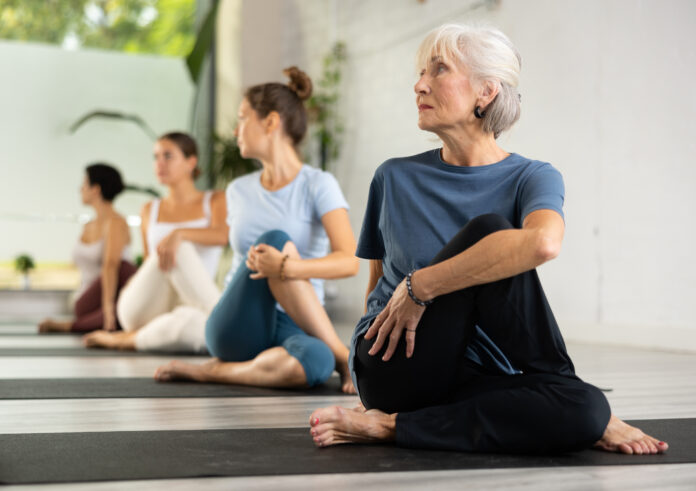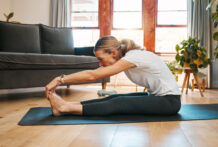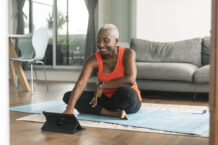Flexibility, the ability to move your joints through their full range of motion, is one of the key elements of fitness, along with cardiovascular endurance and muscle strength. While the benefits of stretching varies from person to person and from joint to joint, the way to maintain or improve flexibility is to stretch. Numerous studies have shown that the muscle elasticity afforded by stretching increases the range of motion of joints and may enhance physical performance. But stretching is not just for joggers, ballet dancers, and athletes. More than anyone, sedentary people need the relief from muscle tension and stiffness that stretching provides. Stretching, when done the right way and regularly, feels good. Improper or excessive stretching, however, may actually increase the likelihood of injury. So the trick is to stretch correctly and in moderation.
Three basic types
Ballistic stretching, which is done by many beginners, is generally the type to avoid. It involves stretching to your limit and performing repetitive, bouncing movements, usually quickly. This may do more harm than good, actually shortening muscles (because of a protective reflex contraction) and increasing the risk of tiny muscle tears, soreness, and injury. In contrast to ballistic stretching, two types are highly recommended because they are slow and gentle:
Static stretching calls for gradually stretching through a muscle’s full range of movement until you feel resistance or the beginning of discomfort. You hold the maximum position for 10 to 30 seconds, relax, then repeat this several times. In static toe touches, for instance, you slowly roll down (with knees bent) towards your toes and hang in the down position without bouncing. Then you slowly roll up.
Proprioceptive neuromuscular facilitation stretching is more complicated. One type is called contract-relax stretching. Here you first contract a muscle against a resistance, usually provided by another person, then relax into a static extension of the muscle (see butterfly stretch, at right). Because it brings the opposing muscle into play, contract-relax stretching is a good way to increase flexibility.
Prelude to a stretch
Stretching should always be preceded by a brief (5- to 10-minute) warm-up, such as jogging in place, riding a stationary bicycle, or a less-vigorous rehearsal of the sport or exercise you’re about to do. Warming up prepares you for exercise by gradually increasing your heart rate and blood flow and by raising the temperature of muscles (and ligaments and tendons), all vital for elasticity and optimal functioning of muscles and connective tissue. Stretching while muscles are cold may sprain or tear them.
11 tips for a stretching program
-
- Try to stretch at least three times a week to maintain flexibility. If you are recovering from an injury or disability, your doctor or physical therapist may tell you to stretch more often—perhaps several times a day.
- An optimal session should last 10 to 20 minutes, with each stretch held at least 10 seconds, working up to 20 to 30 seconds. That will maintain flexibility, but to increase flexibility significantly, stretches should be held for one to two minutes.
- Stretch before exercising or playing a sport to limber up muscles and help prevent muscle strain and perhaps injury.
- Besides a general stretch of major muscle groups, stretch the specific muscles required for your sport or activity.
- If there’s any pain, stop. At worst, any discomfort should be mild and brief.
- Don’t bounce. Stretching should be gradual and relaxed.
- Focus on the muscles you want to stretch, and try to minimize the movement of other body parts.
- Don’t hold your breath during a stretch.
- Remember, always warm up first.
- Stretch after exercise to prevent muscles from tightening up.
- Consider taking up yoga, since one of its benefits is to enhance flexibility.
What stretching can’t do
Stretching before a workout, it used to be assumed, decreases the risk of injury, because tightness makes muscles (along with ligaments and tendons) susceptible to pulls and tears if they are forced beyond their normal range. But a few years ago, a study from McMaster University in Ontario found that runners who said they never stretched before running were no likelier to be injured than those who said they always stretched. Even more surprising, those who only sometimes stretched had the highest risk for injury. These results raised some questions about the conventional wisdom of stretching before exercise.
Since it depended solely on a questionnaire, with only very general questions about stretching, this Canadian study was hardly definitive. Moreover, the runners, especially those who stretched only occasionally, may not have been stretching correctly— and some types of stretching are ineffectual or perhaps even counterproductive. Also, paradoxically, injury-prone athletes are more likely to stretch, which may skew the results. Though there’s a good theory why stretching should be protective and countless anecdotal reports that it is, studies on the link between stretching and injury prevention have yielded contradictory results. One thing is clear, though: cold muscles are more likely to tear than warmer ones, so warming up is an important way to prevent injuries.
Stretching after a workout cannot head off delayed-onset muscle soreness—the kind that generally occurs the day after unaccustomed strenuous exercise. This doesn’t mean you should forgo stretching after a workout: it does promote flexibility and can keep your muscles from tightening up quickly.
Stretching: mind/body workouts
Stretching may affect your mind as well as body. When done in a slow and focused manner, an extended stretching routine can be an excellent relaxation method and stress reducer. For many Western practitioners, this is one of the attractions of yoga.
Among the numerous studies on this subject was one in the Journal of the Royal Society of Medicine, in which researchers found that a stretching-and-breathing routine was as effective as other means of relaxation, but at the same time increased the subjects’ perception of mental and physical energy and alertness. Two studies in the Journal of Behavioral Therapy and Experimental Psychiatry showed that stretching could help tense people reduce anxiety and muscle tension, as well as lower blood pressure and breathing rate.







